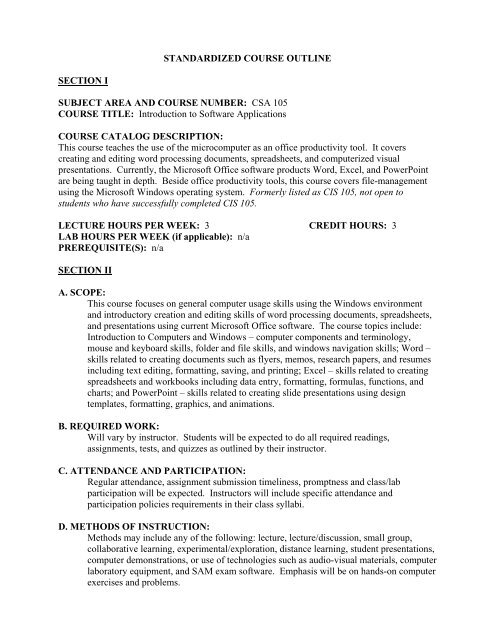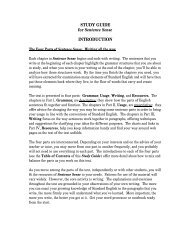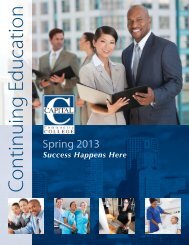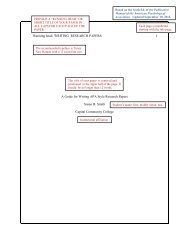STANDARDIZED COURSE OUTLINE
STANDARDIZED COURSE OUTLINE
STANDARDIZED COURSE OUTLINE
You also want an ePaper? Increase the reach of your titles
YUMPU automatically turns print PDFs into web optimized ePapers that Google loves.
SECTION I<br />
<strong>STANDARDIZED</strong> <strong>COURSE</strong> <strong>OUTLINE</strong><br />
SUBJECT AREA AND <strong>COURSE</strong> NUMBER: CSA 105<br />
<strong>COURSE</strong> TITLE: Introduction to Software Applications<br />
<strong>COURSE</strong> CATALOG DESCRIPTION:<br />
This course teaches the use of the microcomputer as an office productivity tool. It covers<br />
creating and editing word processing documents, spreadsheets, and computerized visual<br />
presentations. Currently, the Microsoft Office software products Word, Excel, and PowerPoint<br />
are being taught in depth. Beside office productivity tools, this course covers file-management<br />
using the Microsoft Windows operating system. Formerly listed as CIS 105, not open to<br />
students who have successfully completed CIS 105.<br />
LECTURE HOURS PER WEEK: 3 CREDIT HOURS: 3<br />
LAB HOURS PER WEEK (if applicable): n/a<br />
PREREQUISITE(S): n/a<br />
SECTION II<br />
A. SCOPE:<br />
This course focuses on general computer usage skills using the Windows environment<br />
and introductory creation and editing skills of word processing documents, spreadsheets,<br />
and presentations using current Microsoft Office software. The course topics include:<br />
Introduction to Computers and Windows – computer components and terminology,<br />
mouse and keyboard skills, folder and file skills, and windows navigation skills; Word –<br />
skills related to creating documents such as flyers, memos, research papers, and resumes<br />
including text editing, formatting, saving, and printing; Excel – skills related to creating<br />
spreadsheets and workbooks including data entry, formatting, formulas, functions, and<br />
charts; and PowerPoint – skills related to creating slide presentations using design<br />
templates, formatting, graphics, and animations.<br />
B. REQUIRED WORK:<br />
Will vary by instructor. Students will be expected to do all required readings,<br />
assignments, tests, and quizzes as outlined by their instructor.<br />
C. ATTENDANCE AND PARTICIPATION:<br />
Regular attendance, assignment submission timeliness, promptness and class/lab<br />
participation will be expected. Instructors will include specific attendance and<br />
participation policies requirements in their class syllabi.<br />
D. METHODS OF INSTRUCTION:<br />
Methods may include any of the following: lecture, lecture/discussion, small group,<br />
collaborative learning, experimental/exploration, distance learning, student presentations,<br />
computer demonstrations, or use of technologies such as audio-visual materials, computer<br />
laboratory equipment, and SAM exam software. Emphasis will be on hands-on computer<br />
exercises and problems.
E. OBJECTIVES, OUTCOMES, and ASSESSMENT<br />
Students’ grades will be based on achievement of learning the objectives and outcomes<br />
listed below as measured by the instructor’s methods of assessment:<br />
LEARNING<br />
OBJECTIVES<br />
To demonstrate an<br />
understanding of:<br />
Computer components and<br />
terminology<br />
Basic skills using the<br />
Windows operating system<br />
Basic skills using word<br />
processing software<br />
Basic skills using<br />
spreadsheet software<br />
Basic skills using<br />
presentation software<br />
LEARNING OUTCOMES ASSESSMENT METHODS<br />
Student will: As measured by:<br />
a) Identify, define, and list<br />
examples of various computer<br />
components and terminology<br />
a) Open, close, maximize,<br />
minimize, restore, arrange, and<br />
resize windows<br />
b) Create, rename, move, copy,<br />
paste, and delete files and<br />
folders that are stored in<br />
hierarchical structures<br />
a) Create, save, open, close, and<br />
print documents<br />
b) Insert, cut, copy, paste, delete,<br />
and edit text<br />
c) Format documents using fonts,<br />
colors, sizes, styles, bullets,<br />
numbers, line spacing,<br />
alignments, headers, footers, etc.<br />
d) Insert and manipulate graphics<br />
and tables<br />
e) Create, save, open, close, and<br />
print workbooks and worksheets<br />
f) Insert, cut, copy, paste, delete,<br />
and edit text<br />
g) Format spreadsheets using fonts,<br />
colors, sizes, column and row<br />
spacing, cell alignments, etc.<br />
h) Insert and manipulate formulas,<br />
functions, charts, and graphics<br />
i) Create, save, open, close, and<br />
print presentations<br />
j) Insert, cut, copy, paste, delete,<br />
and edit text and slides<br />
k) Format slides using fonts, colors,<br />
sizes, templates, designs, etc.<br />
l) Insert and manipulate graphics,<br />
charts, tables, and animations<br />
• Homework/Lab assignments;<br />
• Written and Oral activities;<br />
• Quizzes and Exams<br />
• Homework/Lab assignments;<br />
• Written and Oral activities;<br />
• Quizzes and Exams<br />
• Homework/Lab assignments;<br />
• Written and Oral activities;<br />
• Quizzes and Exams;<br />
• SAM testing software;<br />
• Projects and Presentations<br />
• Homework/Lab assignments;<br />
• Written and Oral activities;<br />
• Quizzes and Exams;<br />
• SAM testing software;<br />
• Projects and Presentations<br />
• Homework/Lab assignments;<br />
• Written and Oral activities;<br />
• Quizzes and Exams;<br />
• SAM testing software;<br />
• Projects and Presentations
F. TEXT(S) AND MATERIALS:<br />
An appropriate Microsoft Office and Windows text, such as:<br />
Text: Microsoft Office: Introductory Concepts and Techniques (current edition)<br />
Author: Shelly, Cashman, and Vermaat<br />
Publisher: Course Technology<br />
SAM Testing Software - A testing software provided by the Course Technology<br />
Publisher that tests the skills of students by requiring them to perform tasks in simulated<br />
software platforms<br />
G. INFORMATION TECHNOLOGY:<br />
This course is an information technology course and will require extensive computer lab<br />
time both for teaching and performing assignments. Students will require network<br />
accounts with access to the Internet and current versions of Microsoft Windows, Word,<br />
Excel, and PowerPoint as well as file storage space.







